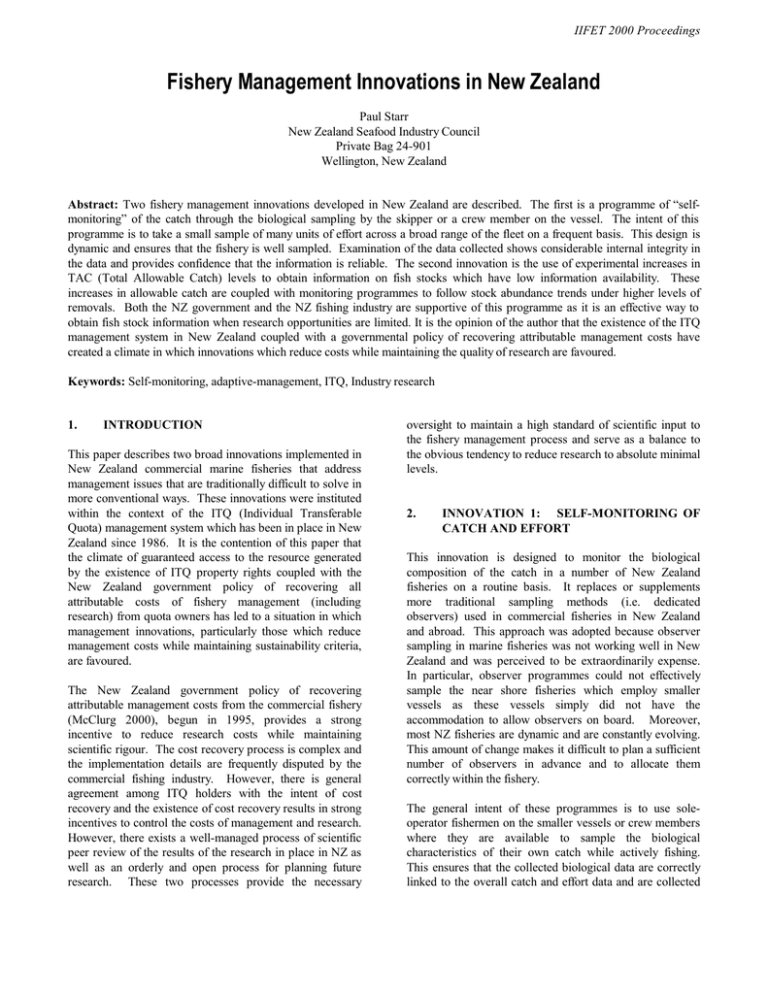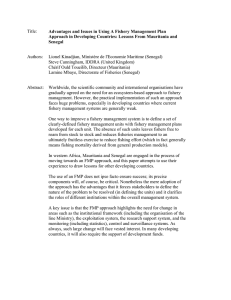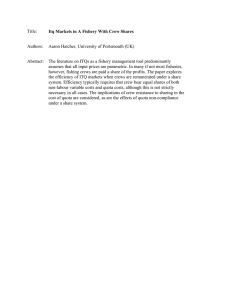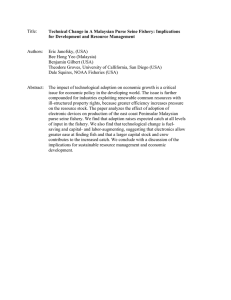Fishery Management Innovations in New Zealand
advertisement

IIFET 2000 Proceedings Fishery Management Innovations in New Zealand Paul Starr New Zealand Seafood Industry Council Private Bag 24-901 Wellington, New Zealand Abstract: Two fishery management innovations developed in New Zealand are described. The first is a programme of “selfmonitoring” of the catch through the biological sampling by the skipper or a crew member on the vessel. The intent of this programme is to take a small sample of many units of effort across a broad range of the fleet on a frequent basis. This design is dynamic and ensures that the fishery is well sampled. Examination of the data collected shows considerable internal integrity in the data and provides confidence that the information is reliable. The second innovation is the use of experimental increases in TAC (Total Allowable Catch) levels to obtain information on fish stocks which have low information availability. These increases in allowable catch are coupled with monitoring programmes to follow stock abundance trends under higher levels of removals. Both the NZ government and the NZ fishing industry are supportive of this programme as it is an effective way to obtain fish stock information when research opportunities are limited. It is the opinion of the author that the existence of the ITQ management system in New Zealand coupled with a governmental policy of recovering attributable management costs have created a climate in which innovations which reduce costs while maintaining the quality of research are favoured. Keywords: Self-monitoring, adaptive-management, ITQ, Industry research 1. INTRODUCTION This paper describes two broad innovations implemented in New Zealand commercial marine fisheries that address management issues that are traditionally difficult to solve in more conventional ways. These innovations were instituted within the context of the ITQ (Individual Transferable Quota) management system which has been in place in New Zealand since 1986. It is the contention of this paper that the climate of guaranteed access to the resource generated by the existence of ITQ property rights coupled with the New Zealand government policy of recovering all attributable costs of fishery management (including research) from quota owners has led to a situation in which management innovations, particularly those which reduce management costs while maintaining sustainability criteria, are favoured. The New Zealand government policy of recovering attributable management costs from the commercial fishery (McClurg 2000), begun in 1995, provides a strong incentive to reduce research costs while maintaining scientific rigour. The cost recovery process is complex and the implementation details are frequently disputed by the commercial fishing industry. However, there is general agreement among ITQ holders with the intent of cost recovery and the existence of cost recovery results in strong incentives to control the costs of management and research. However, there exists a well-managed process of scientific peer review of the results of the research in place in NZ as well as an orderly and open process for planning future research. These two processes provide the necessary oversight to maintain a high standard of scientific input to the fishery management process and serve as a balance to the obvious tendency to reduce research to absolute minimal levels. 2. INNOVATION 1: SELF-MONITORING OF CATCH AND EFFORT This innovation is designed to monitor the biological composition of the catch in a number of New Zealand fisheries on a routine basis. It replaces or supplements more traditional sampling methods (i.e. dedicated observers) used in commercial fisheries in New Zealand and abroad. This approach was adopted because observer sampling in marine fisheries was not working well in New Zealand and was perceived to be extraordinarily expense. In particular, observer programmes could not effectively sample the near shore fisheries which employ smaller vessels as these vessels simply did not have the accommodation to allow observers on board. Moreover, most NZ fisheries are dynamic and are constantly evolving. This amount of change makes it difficult to plan a sufficient number of observers in advance and to allocate them correctly within the fishery. The general intent of these programmes is to use soleoperator fishermen on the smaller vessels or crew members where they are available to sample the biological characteristics of their own catch while actively fishing. This ensures that the collected biological data are correctly linked to the overall catch and effort data and are collected IIFET 2000 Proceedings maximum of 31), determine the sex, and, if female, to determine the maturity stage. in conjunction with the fishing operation. Only a small amount of the catch is sampled as randomly as possible, but it is sampled routinely and frequently, often at the level of every unit of individual fishing effort. This allows for the accumulation of large amounts of information and offsets the fact that only a small amount of data is collected by any single participant. Such a design automatically adjusts to changes in fishing practices, both in area and over time. It is important to note that, in some fisheries (and this has been true in the NZ marine fisheries), biological sampling of the catch is frequently neglected. The yield and stock status estimates from fishery stock assessment models can be very sensitive to how the catch is removed from the population, particularly when maturity and recruitment to the fishery are not equivalent in the life history of the fish. Such a design is also efficient in the sense that it makes use of vessels which are already on the grounds to collect the data. The information is also gathered by those who are most familiar with the fishery. Finally, the design is cost effective as it does away with costly dedicated personnel who are only present on the vessel to collect biological data. 2.1 Figure 1. Map of the main NZ rock lobster fishing areas. Areas with self-monitoring potting programmes include Fiordland (including Stewart Island), Canterbury, East Cape and Bay of Plenty. This programme was run for three years in conjunction with scientific sampling using on-board observers in one area (Fiordland – see Figure 1). A comparative study of the two programmes was presented in Starr and Vignaux (1997) who found, after amalgamating all the data into year, month and statistical area strata, that 35 of the 40 strata available for comparison showed similar length distributions. Of the remaining 5 strata, the research sampling data appeared more anomalous than the fisherman-collected data (they had flat, non-typical distributions; all other distributions showed a strong mode near the minimum legal size). They also found good correspondence with the catch per potlift by weight between the compulsory government logbooks and the fisherman-collected data when lengths were converted to weight. On the basis of this work, the research sampling programme was discontinued in this area and was replaced with the voluntarily-collected biological data. These data are now routinely used in the stock assessments which set the annual yields in those fisheries in which the data are available (Starr et al. 1999). Example 1: Rock lobster potting fishery There is an extensive and valuable spiny lobster (Jasus edwardsii) fishery in New Zealand based on potting which is prosecuted by a diverse inshore fleet of small vessels. Historically this fishery developed in most areas of the NZ coastline, largely by owner-operators. Since the introduction of this fishery into the ITQ system in 1990, the number of owner-operators has declined and there are strong holdings of ITQ by companies which use their ITQ to leverage the quota held by the owner-operators. As early as 1993, rock lobster owner-operators asked fishery scientists in the NZ Ministry of Fisheries and the NZ Fishing Industry Board (the precursor to the NZ Seafood Industry Council) to develop a meaningful sampling programme which could be used in future stock assessments. Such a programme was designed and implemented and is now active in 4 of the 8 main lobster fishing areas in NZ (Figure 1). The design of this programme involves choosing four representative pots from the total 100 to 150 pots which are fished actively every day. The fishermen are told to select pots which appear to have average catch rates rather than to attempt a random selection. The reason for this was that it is felt that it would be too difficult to define a “random” selection process and that it is too easy for the fisherman to select pots on some arbitrary factor (such as high or low expected catch rates). Every time a designated pot is lifted, the fisherman is asked to measure every lobster (up to a 2.2 Example 2: hoki fishery Sampling the NZ Chatham Rise NZ hoki (Macruronus novaezelandiae) form the basis of the largest (in terms of tonnage caught) of the NZ commercial marine fisheries. When the fishery for this species was first developed in the mid-1980s, fishing occurred primarily during the winter months of July and August and was primarily located on the west coast of the South Island where the main spawning aggregations were 2 IIFET 2000 Proceedings found in the Hokitika Canyon (Figure 2). A further spawning population was subsequently found in Cook Strait and this population formed the basis of another important fishery. Both spawning fisheries use either bottom or midwater trawl gear employed by vessels which range in length from less than 30 m to large vessels in the 80 to 100 m classes. Most of the large vessels process their catch at sea. was inadequate to characterise the catch of hoki in this fishery. Therefore, the Hoki Management Company (an association of the hoki ITQ holders) asked fishery scientists from the NZ Seafood Industry Council (SeaFIC) to design a “self-monitoring” programme to estimate the level of catch of small hoki in this fishery. The design of this programme is broadly similar to the programme implemented for the rock lobster potting fishery described above. One tow per day is selected (using a random time of day) from which 100 hoki are randomly chosen for length, sex and maturity stage samples. An important aspect to this programme is that the crew members who undertake this work are trained by SeaFIC staff using a one-day certification course accredited by the NZ Qualifications Authority. SeaFIC staff travel to the ports when these vessels come in to provide the required training. This is also an opportunity for the SeaFIC staff to evaluate each vessel and to select the most appropriate sampling station. Initially, hoki were mainly fished by foreign vessels under charter to NZ companies as there were few domestic vessels available in NZ that could effectively participate in this fishery. As the NZ hoki fishery matured under the ITQ management system, large processing vessels were gradually purchased by the NZ fishing companies on the basis that this was a sustainable fishery with a long-term future. This development also required that these vessels be active throughout the fishing year and hoki fisheries on nonspawning populations were developed. The most important of these is the Chatham Rise fishery which has become the second largest fishery in NZ in terms of tonnage (Figure 2). An important component of the programme is the careful scrutiny of the returned data forms by a dedicated staff person at SeaFIC. Completed data forms are sent in after every trip and immediately logged and key-punched. Crew members are then routinely debriefed based on the information in the data forms and most problems can be resolved at that level. Part of the reason the Chatham Rise is a good location for year-round hoki fishing is the presence in this area of large numbers of juvenile hoki. It is thought that juveniles from both the west coast and Cook Strait spawning populations migrate to this area where they reside for several years before moving to the adult residence areas. Not surprisingly, there is a considerable catch of smaller hoki in this fishery. The catch of these small hoki is marketable but there are sustainability concerns when a large fraction of the catch taken consists of pre-mature fish. Results from the first six months of sampling (1 October 1999 to 31 March 2000) are impressive. Thirty fishing trips involving 16 vessels were successfully sampled, involving nearly 900 trawl tows and measuring nearly 90,000 hoki. Figure 3 shows that there was extensive coverage of the fishery, as provided for in the design. Figure 4 shows that credible length frequency distributions were obtained, including showing considerable differences in the male and female distributions. This difference in distribution by sex is also present in the research trawls from the Chatham Rise and appears to be related to a differential movement of male hoki away from the juvenile rearing area and towards the adult holding areas in the subAntarctic seas. West NW East South Figure 2. Map of the central portion of the NZ EEZ showing the relative locations of the Chatham Rise, the west coast of the South Island (Hokitika Canyon) and Cook Strait which separates the North and South Islands. Note the 1000 m depth contour. Figure 3. Distribution of tows sampled on the Chatham Rise from the Hoki Management Company sampling programme for 1 October 1999 to 31 March 2000. Examination of the NZ government observer data from the Chatham Rise showed that the level of sampling obtained 3 IIFET 2000 Proceedings 2.4 2.5E+06 M ale Problems with Industry-based “self-monitoring” programmes Female N umber of Fis h 2.0E+06 Several types of problems can be identified with this style of “self-monitoring” which need to be considered whenever such a project is implemented. These include: 1.5E+06 x The difficulty to maintain motivation, especially when the samplers are solo owner-operators. x The management of the programme requires a responsible dedicated employee on-shore. Experience has shown that constant feedback between the scientists and the samplers is required. x There is a real cost to fishermen in terms of the labour expended to collect the data. While they are generally not paid to do the work, this is real labour which must be considered as a cost of the programme. x Some stakeholders (e.g. recreational fishers or environmental groups) view such data as unreliable, either because they feel that fishermen can bias the data collected or they believe that fishermen are not competent to collect such data. While it is difficult to see how such activities are credible given the quality of the information collected to date, such concerns need to be considered seriously. x This type of programme seems to work best when focussed on a target species or a common, noncontentious, by-catch species. The intent of this approach is to monitor the primary species of interest where the collection of the data is non-controversial and it can usually be seen that it is in the fishermen’s best interest. This approach does not work well for monitoring the by-catch of rare or protected species, particularly non-fish species such as marine mammals and seabirds. In many instances, the quality of the information deteriorates when fishermen see their livelihoods at serious risk. 1.0E+06 5.0E+05 0.0E+00 30 40 50 60 70 Le ng th 80 90 100 110 Figure 4. Length frequency distributions for male and female hoki from the Hoki Management Company sampling programme for 1 October 1999 to 31 March 2000. 2.3 Extent of Industry-based programmes in New Zealand “self-monitoring” There are now a large number of similar Industry-based “self-monitoring” programmes in New Zealand (Table 1). These programmes have been mainly designed and initially implemented by scientific staff at SeaFIC. But they are fully supported by the appropriate stakeholder associations and in many instances the operation and management of the programmes have been taken over by these associations. Table 1. Current (July 2000) and expected future extent of Industry-based “self-monitoring” programmes in New Zealand Common name Rock lobster Ling Type of Fishery Jasus edwardsii Potting Longline Genypterus blacodes Hoki Trawl Macruronus novaezelandiae Orange roughy Hoplostethus Trawl atlanticus Bluenose Hyperoglyphe Longline & trawl antarctica Rig (Gummy shark) Snapper Species name Mustelus lenticulatus Pagrus auratus Longline & Danish seine Proposed for 1 Oct 2000 Extend hoki & Trawl orange roughy Elephantfish Callorhynchus Setnet & trawl milii Snapper Pagrus auratus Trawl Extent of programme 4 areas 3 areas 2 areas 2 areas 3. 3 longline areas & 1 trawl area 2 areas INNOVATION 2: EXPERIMENTAL INCREASES IN CATCH LIMITS Perhaps one of the more difficult problems facing ITQ management under uncertainty coupled with restrictive legislation is providing for the exploration and development of new fisheries. This is particularly the case for fisheries which have little information available and have little prospect of obtaining additional information due to the low value of the fishery. In New Zealand, a programme has been developed which allows for experimental increases in the TAC (Total Allowable Catch) coupled with a monitoring programme to track the response of the fish stock to the increased level of exploitation. Northern NZ Several areas East coast South Island Northern NZ This programme is termed “Adaptive Management” in New 4 IIFET 2000 Proceedings Zealand although it strictly does not conform to the expectation of most managers with regard to this phrase. Specifically, the New Zealand version of “Adaptive Management” allows for modest increases in the TAC in instances where it is believed that there is a strong likelihood that the stock abundance is above the optimal yield level. While it is acknowledged that this is level which is unknown as is the stock status level, the expectation is that, on the “balance of probabilities”, the stock is more likely to be above than below the optimal reference point demanded by the NZ fisheries legislation. The TAC for this species in this area was raised from 700 t to 1000 t in October 1996. This new TAC has been caught or nearly caught in each subsequent fishing year. The monitoring programme has shown where the fishery is primarily located (Figure 5) and the biomass index has begun to rise after an initial drop (Figure 6). 001 048 002 047 003 This programme was begun in 1991 but it was not until 1996 that strong controls were put in place to ensure that the monitoring requirements associated with these fisheries were maintained. Frequently, the “self-monitoring” innovation described above is a key element of the monitoring programme associated with the “Adaptive Management” approach. However, it is often difficult, even with the prospect of increases in allowable catches, to maintain adequate levels of participation in one of these programmes (see Section 2.4 above). 046 045 011 009 x 3.1 010 041 012 Figure 5. Distribution of longline shots in northern New Zealand reported by participants in the experimental “adaptive management” TAC increase for bluenose. Dots are the locations of reported longline shots over the period October 1996 to September 1999 The initial proposal is presented to a peer-review scientific committee open to representatives of all stakeholders. This committee approves the underlying rationale for introducing the fish stock into the programme, the proposed monitoring programme, and the “decision rule” which specifies how the data from the monitoring programme will be interpreted. 1.4 1.2 1.0 0.8 0.6 An annual review of the results of the monitoring programme is presented to the same peer-review scientific committee. If it is found that the “decision rule” criteria have been triggered, the committee is required to interpret these results in the light of all the available information. 0.4 0.2 Triggering the “decision rule” criteria is usually interpreted that the TAC increase was not sustainable and the experimental increase is then put back to the previous level. 1998-99 1997-98 1996-97 1995-96 1994-95 1993-94 1992-93 1991-92 1990-91 0.0 1989-90 x 008 042 These programmes have the following safeguards: x 004 Figure 6. Biomass trend for northern New Zealand bluenose from the experimental “adaptive management” TAC increase for bluenose. 3.2 Example: Northern NZ “bluenose” Bluenose (Hyperoglyphe antarctica) is a wide-ranging demersal species which is also common in Australia where it is known as “trevalla”. It has an extensive distribution in the more northerly NZ waters, usually being found in aggregations around “features” such as seamounts, gullies, or other irregularities, where it is targeted primarily by longline gear but also is an important by-catch in a bottomtrawl fishery targeted at alfonsino (Beryx splendens), a species which is frequently found in association with bluenose. Extent of “Adaptive Management” programmes in New Zealand There are presently many of these experimental “adaptive management” programmes in New Zealand (Table 2). These programmes have been implemented by the ITQ holders with the assistance of scientific staff at NZ SeaFIC. Other programmes initiated in the past have been dropped for various reasons, including observed declines in the biomass index (as determined by the monitoring programme) which was deemed to indicate that the granted increase was not sustainable. 5 IIFET 2000 Proceedings the knowledge for the fish stock. In both cases, it is felt that the situation created by the ITQ property rights management system, coupled with the NZ government policy of recovering attributable management costs directly from the ITQ owners, has led to a climate where such innovations are favourably received. Both the NZ government fisheries management agency and the NZ ITQ owners are fully supportive of these programmes because they offer management opportunities which would normally be difficult or expensive to implement. Table 2. Current (July 2000) extent of experimental “adaptive management” programmes in New Zealand Common name Bluenose Species name Number of areas & type of fishery in AMP 3 longline areas & 1 mixed longline & trawl area 2 trawl areas Hyperoglyphe antarctica Stargazer Kathetostoma (monkfish) giganteum Orange roughy Hoplostethus 1 trawl area atlanticus Rig (Gummy Mustelus 2 setnet areas shark) lenticulatus Red gurnard Chelidonichthys 1 trawl area kumu 3.3 5. McClurg, Tom, Cost recovery in New Zealand, Presentation in “Innovations in Fishery Management” Session, IIFET 2000 Conference, 2000. Problems with “Adaptive Management” programmes in New Zealand There are several issues that have emerged with the implementation of the New Zealand “adaptive management” programmes. These include: x A frequent objective in these programmes is to encourage exploration to new fishing areas. This often does not always take place because it is usually easier to take the additional catch in known locations. Fishermen resent being told what to do so the exploratory aspect is often haphazard unless specifically designed into the programme. x A potential failure of the research aspect of programme due to lack of interest by the participants or the inadequacy of the chosen method. The usual response by government is to rescind the increase, but this may not address the real problem which is that monitoring the fish stock may not be feasible even if research funding were not limiting. Some fish species cannot be monitored with any known methodologies. 4. Starr, P.J., N. Bentley and M. Maunder, Stock assessment of two New Zealand rock lobster substocks, New Zealand Fisheries Assessment Research Document 99/34, 44 p, 1997. A tendency to use this approach to alleviate bycatch problems. However, this programme, particularly the monitoring aspect, works best with a target species or at least an important bycatch. Frequently, these projects are failures when the target fishery changes or the abundance of the bycatch species drops off. x REFERENCES Starr, P.J. and M. Vignaux, Comparison of data from voluntary logbook and research catch-sampling programmes in the New Zealand lobster fishery, Marine and Freshwater Research, 48(8), 10751080, 1997. CONCLUSIONS Both of the innovations described here are interesting in that the initiatives have largely come directly from the fishing industry and the ITQ holders. In the first innovation, there was an incentive to keep research costs at a minimum while maintaining a high scientific standard. In the second innovation, legislative and other administrative obstacles often conspire to maintain the status quo with regard to TAC rather than using the fishery itself as a tool to increase 6






